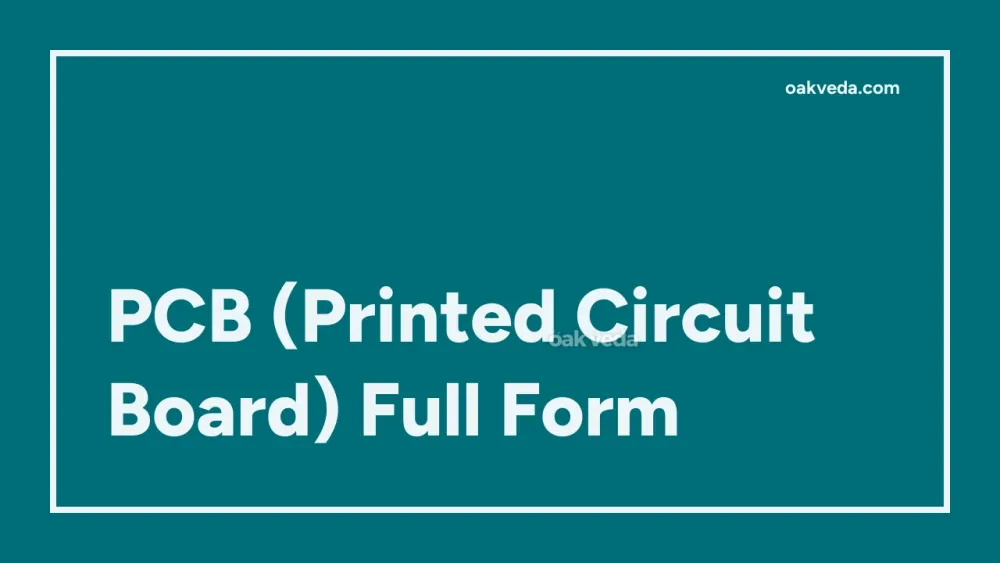
What is the Full Form of PCB?
The full form of PCB is Printed Circuit Board. PCBs are essential components in modern electronics, serving as the foundation for connecting and supporting various electronic parts in a compact and efficient manner.
What is a Printed Circuit Board?
A Printed Circuit Board (PCB) is a flat board made of non-conductive material, typically fiberglass, composite epoxy, or other plastics, that contains conductive pathways etched or "printed" onto its surface. These pathways, usually made of copper, connect different electronic components such as resistors, capacitors, integrated circuits (ICs), and transistors, allowing electrical current to flow between them.
Origin and Development of Printed Circuit Boards
The history of PCBs dates back to the early 20th century:
- 1936: Austrian engineer Paul Eisler invented the printed circuit as part of a radio set while working in the United Kingdom.
- 1940s: PCBs were used by the United States military during World War II for proximity fuzes.
- Post-World War II: The technology was released for commercial use, leading to widespread adoption in various industries.
- 1950s-1960s: Single-sided PCBs became common in consumer electronics.
- 1970s-1980s: Double-sided and multi-layer PCBs were developed, allowing for more complex circuit designs.
- 1990s-present: Advancements in PCB technology continue, with the development of flexible PCBs, high-density interconnect (HDI) boards, and other innovations.
How do Printed Circuit Boards work?
PCBs function by providing a stable platform for electronic components and creating electrical connections between them. The process involves:
- Design: Engineers create a schematic of the circuit using computer-aided design (CAD) software.
- Fabrication: The PCB is manufactured by etching copper pathways onto the board's surface.
- Assembly: Electronic components are soldered onto the board, either manually or through automated processes.
- Testing: The completed PCB is tested to ensure proper functionality and connectivity.
Types of Printed Circuit Boards
There are several types of PCBs, including:
- Single-sided PCBs: Conductive material on one side only
- Double-sided PCBs: Conductive layers on both sides of the board
- Multi-layer PCBs: Multiple layers of conductive material separated by insulating layers
- Flexible PCBs: Made from flexible materials, allowing them to bend or flex
- Rigid-flex PCBs: Combination of rigid and flexible board technologies
Functions of Printed Circuit Boards
PCBs serve several crucial functions in electronic devices:
- Providing mechanical support for electronic components
- Creating electrical connections between components
- Dissipating heat generated by components
- Shielding components from electromagnetic interference
- Organizing complex circuits in a compact space
Applications of Printed Circuit Boards
PCBs are ubiquitous in modern electronics, finding applications in:
- Consumer electronics: Smartphones, laptops, televisions, digital cameras
- Automotive industry: Engine control units, infotainment systems, safety features
- Aerospace and defense: Avionics, communication systems, radar equipment
- Medical devices: Diagnostic equipment, implantable devices, monitoring systems
- Industrial automation: Control systems, sensors, robotics
- Telecommunications: Network routers, switches, base stations
Features of Printed Circuit Boards
Modern PCBs boast several advanced features:
- Through-hole technology: Reinforces component connections and board strength
- Surface-mount technology (SMT): Allows for smaller components and higher density designs
- Multi-layer construction: Enables complex circuit designs in a compact form factor
- High-quality base materials: Ensures durability and reliability
- Specialized coatings: Protect against environmental factors and improve performance
Benefits of Printed Circuit Boards
PCBs offer numerous advantages in electronic design and manufacturing:
- Compact design: Allows for miniaturization of electronic devices
- Consistency: Ensures uniform production of electronic circuits
- Cost-effective: Reduces manufacturing costs for large-scale production
- Ease of repair: Simplifies diagnostics and component replacement
- Reduced noise: Minimizes electromagnetic interference between components
- Improved reliability: Increases the lifespan of electronic devices
- Flexibility: Supports complex circuit designs and modifications
Limitations or Challenges of Printed Circuit Boards
Despite their many benefits, PCBs do have some limitations:
- Heat dissipation: Dense designs can lead to heat management issues
- Cost for low volumes: Initial setup costs can be high for small production runs
- Difficulty with fine-pitch components: Challenges in working with extremely small components
- Environmental concerns: Some PCB materials and manufacturing processes can be harmful to the environment
- Vulnerability to extreme conditions: Susceptibility to thermal shock and vibration in harsh environments
Future Developments in PCB Technology
The field of PCB technology continues to evolve, with several exciting developments on the horizon:
- 3D printed electronics: Additive manufacturing techniques for creating PCBs
- Embedded components: Integrating electronic components directly into the PCB structure
- Biodegradable PCBs: Environmentally friendly materials and manufacturing processes
- Artificial Intelligence in PCB design: AI-assisted optimization of circuit layouts and component placement
- Quantum computing PCBs: Specialized boards designed for quantum computing applications
FAQs on PCB Full Form
-
What does PCB stand for in electronics? PCB stands for Printed Circuit Board in electronics.
-
Are all circuit boards PCBs? While most modern circuit boards are PCBs, there are other types of circuit boards, such as wire-wrapped boards or point-to-point constructed circuits.
-
Can PCBs be recycled? Yes, PCBs can be recycled, but the process is complex due to the various materials used in their construction.
-
How long do PCBs last? The lifespan of a PCB depends on various factors, but well-designed and properly maintained PCBs can last for decades.
-
Are PCBs used in all electronic devices? PCBs are used in the vast majority of electronic devices, but some simple or specialized electronics may use alternative circuit construction methods.
By understanding the full form of PCB and its significance in modern electronics, we can appreciate the crucial role these components play in our increasingly connected world. As technology continues to advance, PCBs will undoubtedly evolve to meet the demands of future electronic innovations.
You may be interested in:

